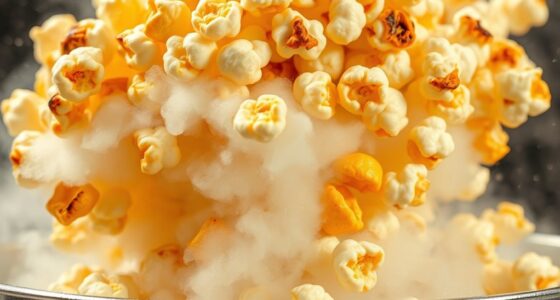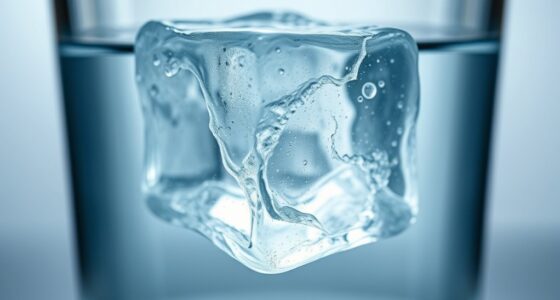The science of ice cream involves understanding ingredients like milk, sugar, and fat, which create its creamy texture and flavor. Freezing point depression from sugars and otherwise prevents the mixture from freezing solid, giving it smoothness. Tiny ice crystals form through controlled cooling, while fat and air contribute to richness and lightness. Advanced techniques help stabilize these elements, ensuring the perfect scoop. Keep exploring to discover how these microscopic processes impact every delicious bite.
Key Takeaways
- Freezing point depression from sugars and solutes allows ice cream to remain soft below 0 °C.
- Small ice crystals formed during rapid freezing create a smooth, creamy texture.
- Fat globules coat ice crystals, stabilizing the emulsion and enhancing flavor and mouthfeel.
- Air incorporation during churning increases volume and lightness, contributing to a desirable texture.
- Stabilizers and emulsifiers control ice crystal growth and prevent recrystallization for better shelf stability.
Composition and Phases of Ice Cream
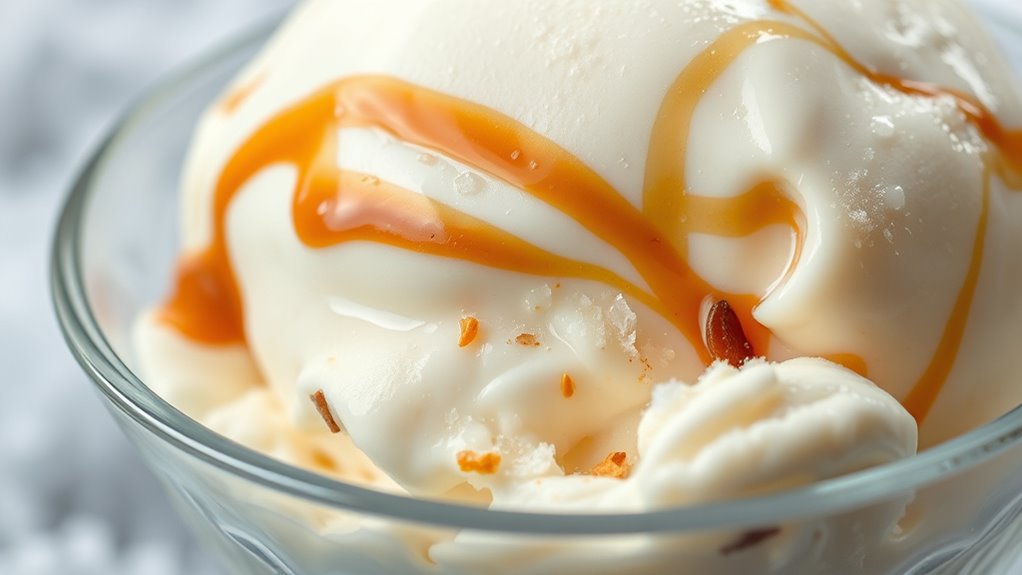
Ice cream’s appealing texture and flavor result from its carefully balanced composition and distinct phases. You have primary ingredients like milk, cream, sugar, and stabilizers such as gelatin or egg yolks, which form the base. The fat content varies, influencing richness and mouthfeel. Emulsifiers like lecithin help smoothly blend fats and water components. During churning, air bubbles are incorporated, adding volume and lightness. The solid phase includes ice crystals and fat globules, giving structure and smoothness, while the liquid phase contains sugars and dissolved flavors that enhance taste. Gas phase, composed of trapped air, lightens the product. Temperature controls the balance among these phases, affecting texture and consistency. Small ice crystals are essential for a smooth, enjoyable mouthfeel, preventing ice crystal growth. Proper temperature control is crucial throughout the process to maintain the ideal phase balance and ensure a high-quality product. Additionally, the freezing point depression caused by sugars plays a vital role in controlling ice crystal formation and texture.
The Role of Freezing Point Depression
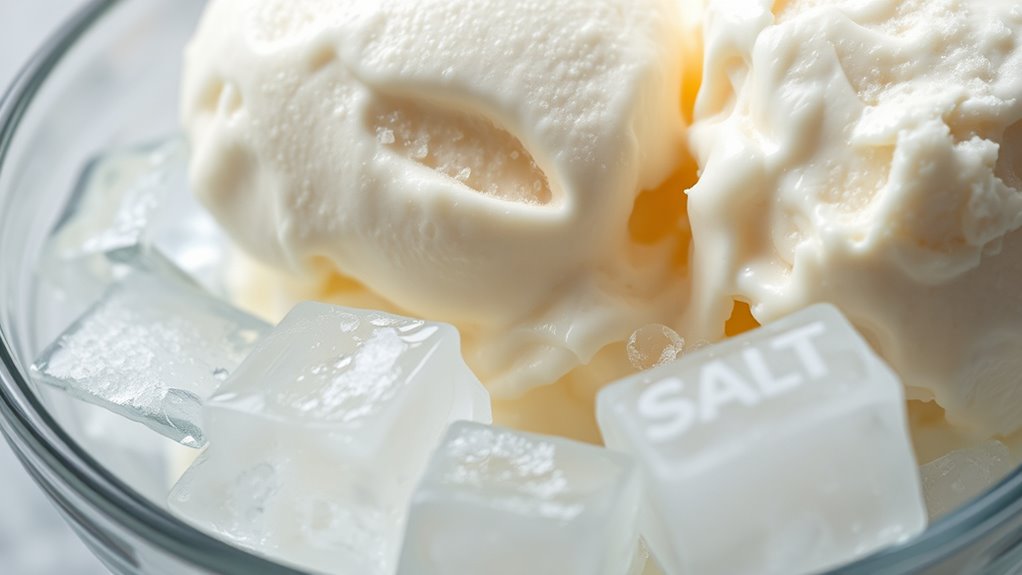
Freezing point depression (FPD) plays a crucial role in shaping the texture and softness of ice cream. When solutes like sugars, salts, and alcohols dissolve, they lower the mixture’s freezing point, meaning ice forms at temperatures below 0 °C. This phenomenon explains why adding ingredients such as sugar or alcohol can make ice cream softer and more scoopable. This process depends on the number of solute particles, not their type, so different sugars influence FPD differently. Typically, ice cream freezes around -3 °C because these solutes prevent full solidification at standard freezing temperatures. The extent of freezing point depression can be precisely calculated using colligative property formulas. FPD enables partial freezing, leaving a viscous, unfrozen phase that contributes to creaminess. It also determines how soft or scoopable the ice cream is at serving temperatures. Understanding the colligative properties that govern FPD helps in designing recipes with the desired texture and consistency.
Ice Crystal Formation and Texture Control
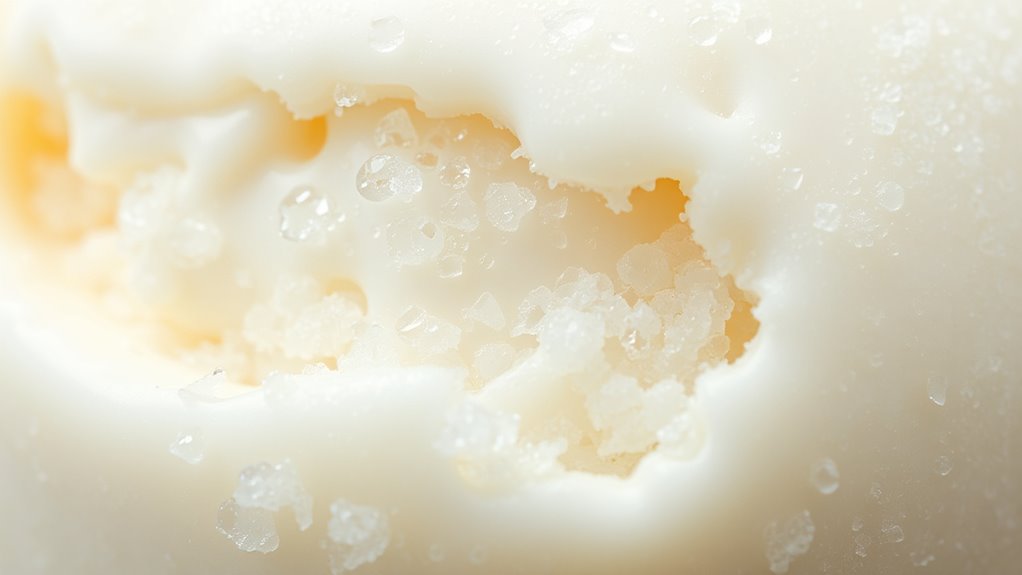
During the process of making ice cream, small ice crystals form through nucleation when the mixture’s temperature drops between 0°C and 4°C. In a scraped-surface freezer, rapid nucleation occurs on the cold wall, creating numerous tiny crystals that disperse into the mix. The number of nucleation points directly influences crystal size; more points produce smaller crystals and a smoother texture. During dynamic freezing, agitation helps distribute crystals and incorporate air, affecting overall mouthfeel. After nucleation, crystals grow by attracting nearby water molecules in a process called ripening, which enlarges crystals over time. Temperature fluctuations during storage cause recrystallization, leading to larger, coarser crystals. Controlling freezing rate and stabilizers helps keep crystals small, ensuring a creamy, smooth final product. Recrystallization is primarily driven by temperature changes during storage, which can significantly impact the texture over time.
The Impact of Fat and Air on Texture and Flavor
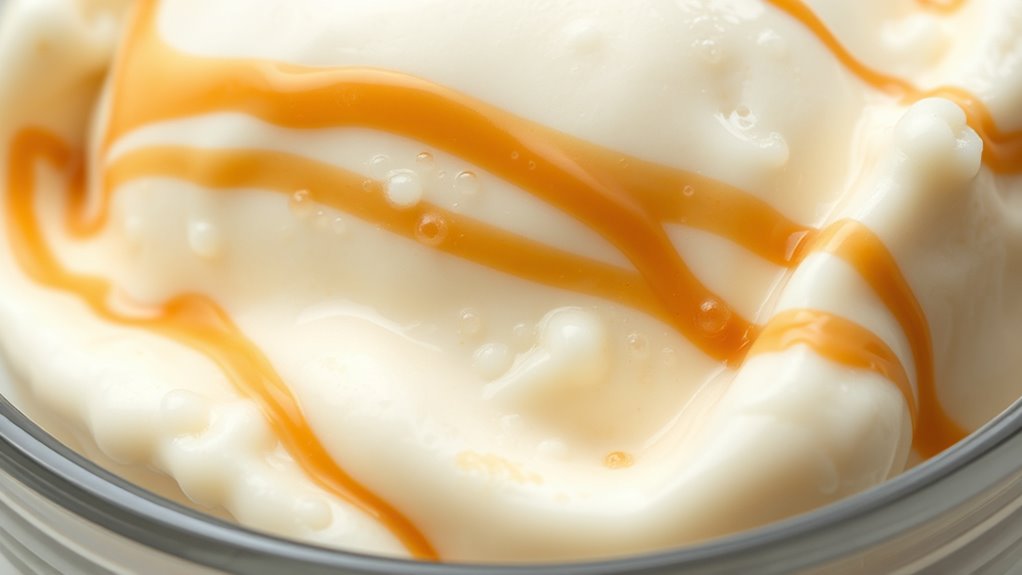
Fat and air are key ingredients that directly influence the texture and flavor of ice cream. Fat creates a smooth, stable texture by coating ice crystals and preventing their growth, while also stabilizing the emulsion of water and fat for uniformity. It insulates ice crystals, slowing melting and extending shelf life. Fat also enhances flavor by absorbing and intensifying flavors, delivering a rich, creamy profile, and providing a lingering taste.
Air, incorporated during churning, lightens the ice cream and improves smoothness by reducing iciness. It increases volume and balances sweetness, while trapped air bubbles need stabilization to maintain texture. The interplay of fat and air fosters a creamy, stable structure, making the ice cream both enjoyable and flavorful.
Proper balance ensures excellent mouthfeel and taste.
Industrial Techniques and Ingredient Influences
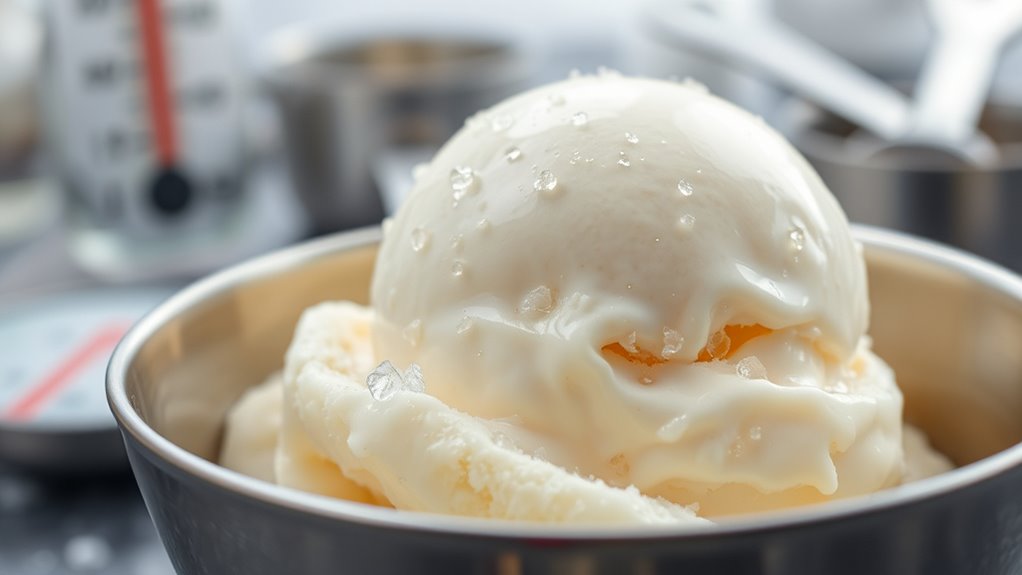
Industrial techniques and ingredients play a crucial role in shaping the texture and quality of ice cream. You begin with blending and mixing to create a uniform base, ensuring all components dissolve properly.
Pasteurization then heats the mixture to eliminate bacteria and dissolve additives, while homogenization reduces fat globule size for a smoother texture. Afterward, the mix is cooled and aged, allowing flavors to develop and stability to improve.
Freezing—either continuous or batch—locks in the desired consistency. Ingredients like emulsifiers stabilize fat and water, stabilizers prevent ice crystal growth, and sweeteners adjust freezing points and flavor. Egg yolks enrich custard styles, and proteins help maintain structure.
Understanding the role of stabilizers is essential for controlling ice crystal size and achieving a creamy texture in the final product. These techniques and ingredients work together to produce the creamy, stable ice cream you enjoy.
Frequently Asked Questions
How Does Temperature Fluctuation Affect Ice Cream’s Texture Over Time?
You should know that temperature fluctuations cause ice crystals in your ice cream to grow larger over time. When temperatures rise and fall, recrystallization occurs, making the texture grainy and icy.
These cycles also melt and refreeze the crystals unevenly, worsening the quality. To keep your ice cream smooth and creamy, store it at consistent, cold temperatures and avoid frequent temperature changes during handling and storage.
Can Alternative Sweeteners Alter the Freezing Point Depression Differently?
Imagine a scoop of ice cream melting in your mouth, each bite revealing a different texture.
Alternative sweeteners like erythritol, maltitol, and xylitol can change the freezing point depression, making your treat softer or harder.
You’ll notice that some, like erythritol, depress the freezing point more strongly, creating a creamier texture.
Blending these sweeteners allows you to fine-tune the ice cream’s firmness and mouthfeel, giving you the perfect scoop every time.
What Is the Ideal Size of Ice Crystals for Optimal Mouthfeel?
You want small, evenly distributed ice crystals for the best mouthfeel. Ideally, they should be around 10 to 50 microns in size. Smaller crystals make your ice cream smooth and velvety, while larger ones cause an icy, coarse texture.
To achieve this, use rapid freezing methods, maintain consistent low temperatures, and include stabilizers. Proper ingredient selection and equipment maintenance help guarantee your ice cream stays delightfully creamy.
How Do Stabilizers Interact With Other Ingredients During Storage?
Think of stabilizers as the unsung heroes quietly weaving a web inside your ice cream. During storage, they team up with water, proteins, and emulsifiers, thickening and binding to prevent ice crystals from growing unruly.
They slow down melting, keep texture smooth, and maintain flavor integrity. By forming a resilient network, stabilizers guarantee each scoop remains creamy and delightful, even after weeks in the cold.
Does the Type of Fat Influence the Melting Rate of Ice Cream?
Yes, the type of fat affects how quickly ice cream melts. Different fats and their crystallization behaviors influence the structure and melting properties.
For example, milk fat helps stabilize texture and resists melting more than other fats. Emulsifiers also modify fat destabilization, impacting melting rates.
Conclusion
Now that you understand the chemistry behind ice cream, you’re better equipped to appreciate its perfect texture and flavor. Remember, “a little knowledge is a dangerous thing,” but in this case, it’s delightful! By controlling freezing points, ice crystal size, and ingredient balance, you can craft or choose the creamiest, most satisfying dessert. So go ahead, indulge with confidence—after all, science has your back in every scoop!



